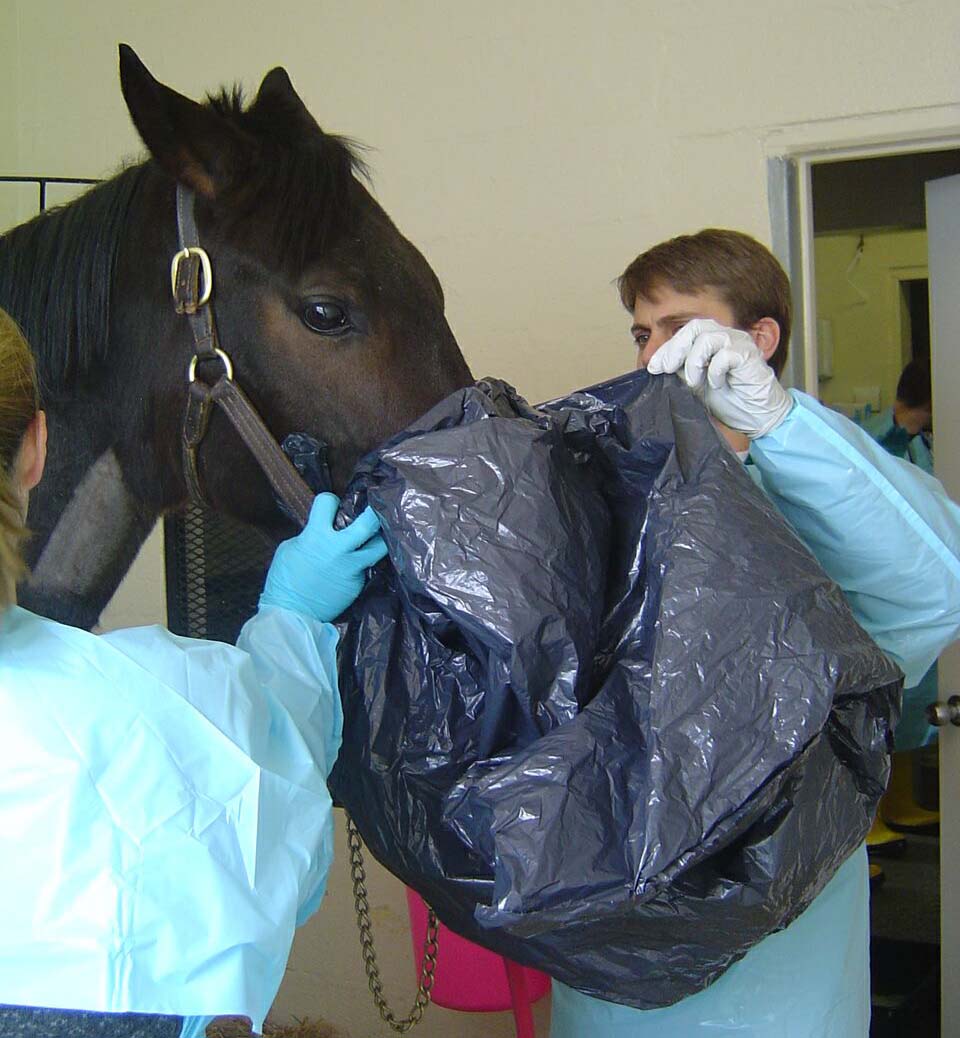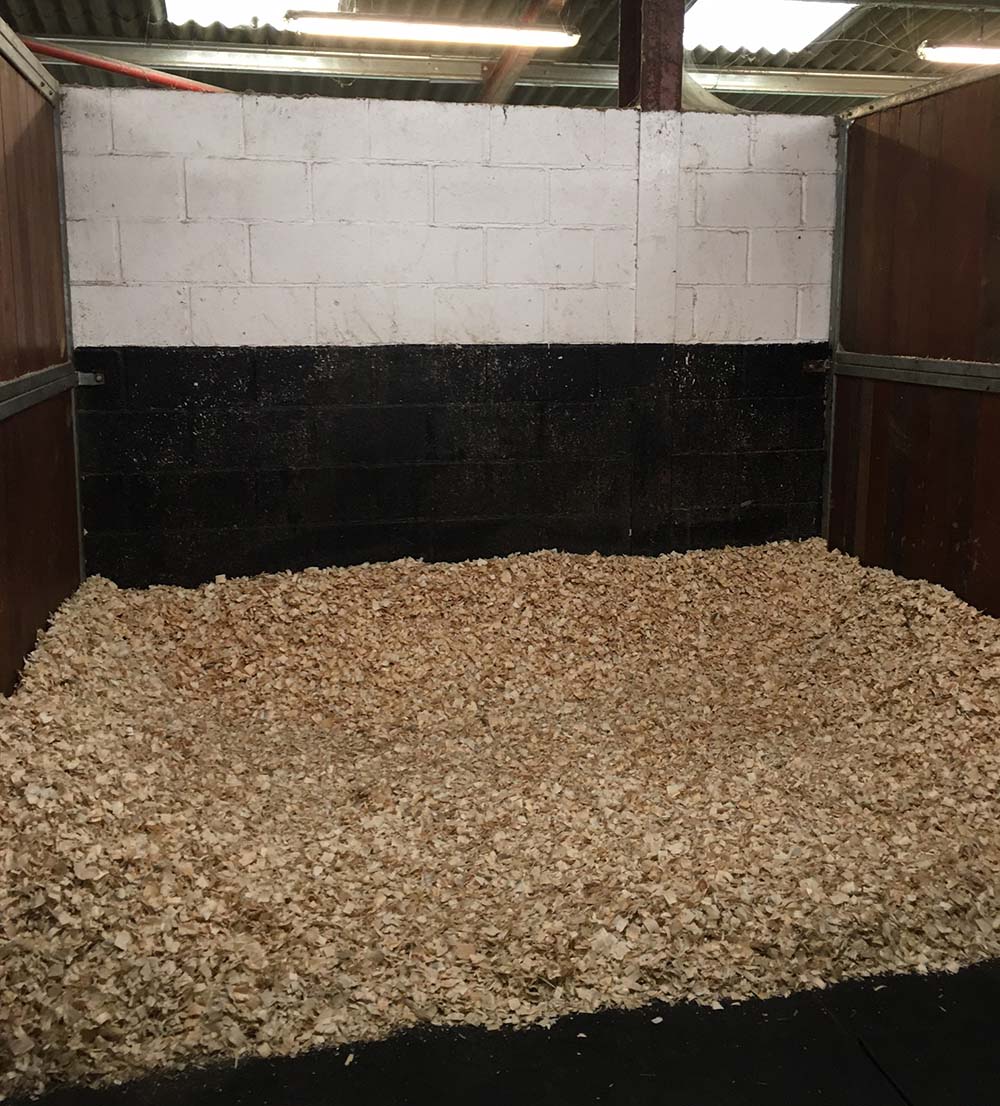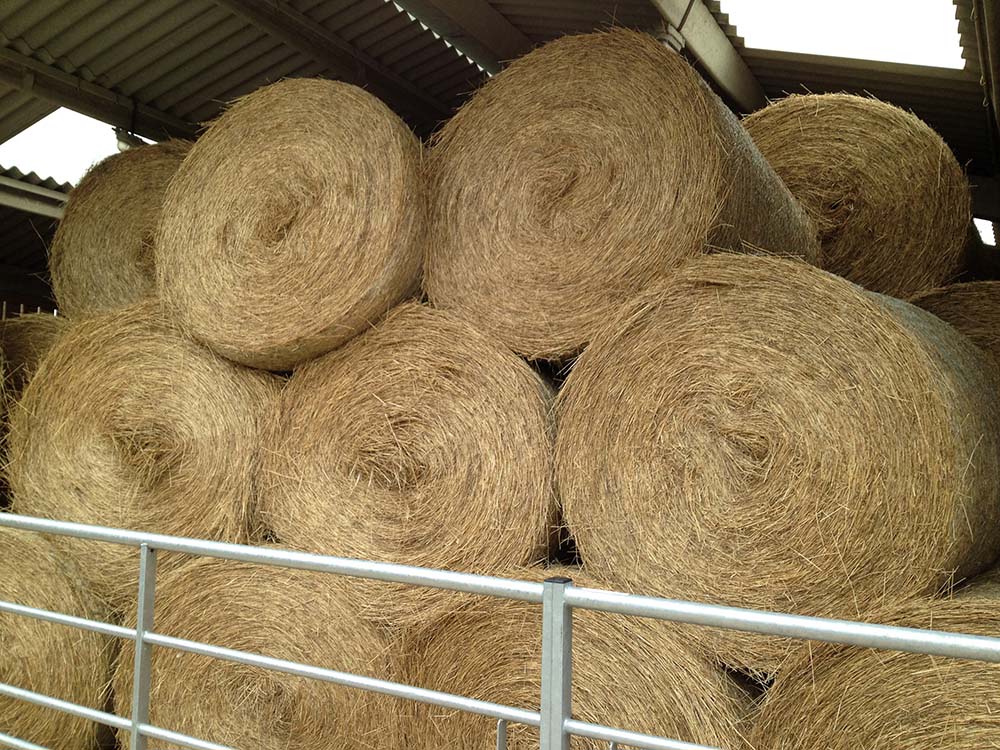10 Nov 2022

Rebreathing examination can be useful to help identify more subtle auscultatory abnormalities.
Severe equine asthma (SEA; formerly known as heaves or recurrent airway obstruction) is a chronic condition of older horses characterised by repeated episodes of reversible airway inflammation and bronchoconstriction. The disease is believed to occur as a result of an allergy to inhaled organic moulds and possibly endotoxins, and susceptible horses develop clinical signs when exposed to high levels of these allergens. Antigen avoidance is considered the best way to successfully manage these horses, in most cases allowing horses to be managed without the need for medical therapy.
In some cases – for example, during an episode of severe clinical signs or where antigen avoidance is not possible – medical management may be necessary. The goals of therapy in these situations are to control airway inflammation and relieve bronchoconstriction. Although bronchodilators are an important part of the treatment strategy, they allow for only symptomatic relief and, as such, corticosteroids should be considered the mainstay of medical therapy of horses with asthma. Newer therapies may become available in the future that may limit the need for treatment with corticosteroids in horses with SEA.
This article will focus on a holistic approach to the diagnosis, treatment and long-term control in horses with SEA, as well as newer developments that may be beneficial in the future.
Severe equine asthma (SEA) – formerly known as recurrent airway obstruction or heaves – is a chronic, performance-limiting, and in some cases debilitating disorder characterised by recurrent episodes of airway obstruction following exposure to allergens in dust and mould1.
A diagnosis of SEA commits a horse owner to long-term (lifelong) management of the condition, which can only be successful when all facets of asthma treatment and control are considered and implemented to the greatest extent.
While medical treatment of SEA is relatively straightforward on paper, helping owners optimise treatment strategies that take into account the owner’s ability to medicate up to several times a day, the horse’s tolerance in particular to inhaled medications, and identifying potential risk factors such as pre-existing conditions (laminitis in particular) can add to the challenge of developing an individual treatment plan for each horse.
Likewise, while we know the vast majority of horses with SEA can be successfully managed long term when housed in a suitable low-allergen environment (outside with low dust feed fed as necessary), for many owners this is simply not possible due to livery yard restrictions or shared barn arrangements.
Helping owners optimise the conditions their horse is housed in, bearing in mind these restrictions, is one of the key components in managing the long-term health of horses with SEA. For many owners, management of chronic conditions such as asthma can be emotionally (and financially) challenging.
Helping these owners develop a realistic, long-term health plan that takes into account the severity of disease, frequency of flare-ups, response to medications, ability to modify the environment and athletic requirements of the horse will help owners take ownership of their horse’s condition, helping their horse remain healthier with fewer flare-ups and optimising long-term welfare.
This article will discuss how this holistic approach to the management of SEA can be implemented. The term “holistic”, when used in a medical context, refers to an approach to treatment of the whole person (horse), taking into account mental and social factors, rather than just symptoms of disease.
Effective long-term management of chronic conditions such as SEA will benefit from a holistic approach, allowing vets to make an initial diagnosis and then develop a treatment plan in conjunction with the owner or carer. A key component to this approach is to educate owners about the condition so they can make informed contributions as to how to best treat their horse, taking into account its temperament, their ability to treat the horse and the environment the horse lives in.
This article focuses predominantly on the syndrome of SEA; although, in many instances, the treatment and management will be directly transferable to the less severe manifestations of the disorder. Summer pasture-associated asthma is not discussed in detail.
The syndrome of SEA occurs following exposure to airborne allergens, thought to exist mostly in organic dust and mould, resulting in inflammation, mucus production and bronchoconstriction within the airways.
More than 50 types of allergens have been identified in hay and straw dust, and in SEA-predisposed horses, clinical signs develop rapidly following exposure. Despite perhaps the majority of horses being exposed to similar levels of possible antigens, the estimated prevalence of the disorder in horses in the northern hemisphere is 14%, suggesting the disorder has a multifactorial aetiology, with a genetic predisposition suspected in some warmblood horses2,3.
In periods of disease exacerbation, horses with SEA will show varying degrees of laboured breathing (nostril flare, increased thoracic excursion, anal “pumping”), increased respiratory rate and abnormal thoracic auscultation (classically, end expiratory wheezes). Some horses will lose significant amounts of weight if the disorder is poorly controlled, presumably due to the increased work of breathing and/or less time spent eating due to the laboured breathing.
During clinical remission, if the disease is well controlled, clinical signs should be absent, although some horses will continue to show signs at exercise (cough, poor exercise tolerance) and abnormal auscultation may persist – especially if a rebreathing bag is used. Horses are typically afebrile, and if a nasal discharge is present, it is mucoid rather than purulent.

Confirmation of the diagnosis should be pursued by endoscopy and cytological evaluation of bronchoalveolar lavage (BAL) fluid (BALF). If the horse is showing marked respiratory signs, delaying these tests may be sensible as some horses do not tolerate the procedure well when significant bronchoconstriction is present.
BALF, rather than a tracheal wash aspirate, is preferred as the disorder is associated with small/distal airway pathology (which is the site sampled during a BAL), rather than a mixed small and large airway sample (tracheal wash). Historically, a poor correlation between tracheal wash and BALF cytology has been shown – and, therefore, when possible, a BAL should be performed4.
The procedure can be performed endoscopically or via a BAL tube, with neither method shown to be superior. A neutrophil count of greater than 20% of BALF cells is considered consistent with a diagnosis of SEA; although, this number is somewhat debated between researchers, with values above 5% or 10% considered abnormal in some studies.
Interestingly, in human asthma, up to one-third of patients diagnosed with asthma did not actually have the disease (in most cases due to lack of appropriate diagnostic testing or interpretation of those tests) suggesting the diagnostic challenges in equine asthma are not unique.
Despite marked airway inflammation, systemic (blood) markers of inflammation are typically not raised in horses with SEA. Should these markers be raised and/or the horse is febrile, an infectious respiratory disorder should be suspected and culture of a percutaneous tracheal aspirate may be warranted.
Equine multinodular pulmonary fibrosis is a rare disorder that can cause clinical signs similar to SEA. Horses can also be intermittently febrile and may have increased inflammatory markers. The disease is typically diagnosed following lack of response to treatment for suspected SEA and/or bacterial respiratory disease, with radiographs showing a typical nodular pattern.
Various steps are involved in the treatment of SEA.
As triggers for SEA are known to exist in hay, straw and associated organic dust, it follows that the most effective long-term management strategy is antigen avoidance.
Indeed, horses can be effectively treated and remain in remission with normalisation of BALF neutrophilia, reversal of bronchoconstriction, and reduction in airway remodelling when housed at pasture and fed a pelleted diet. However, for many clients, this type of management is not possible or desirable – and, therefore, strategies to reduce dust in the stable environment need to be implemented.
Ideally, all horses that share a breathing space with the affected horse should be treated similarly. Panel 1 highlights some of the key strategies.
Ideal
If stabling is necessary
The importance of environmental management cannot be overemphasised, and therapeutic management is unlikely to be successful unless these are undertaken. Owner compliance with recommended management strategies has been explored in two studies – one that recommended general “dust reduction” strategies5 and one that was more specific, listing six points owners should address6.
Not surprisingly, (self-reported) owner compliance was greater in the first study and was considered “poor” (less than two out of the six points addressed) in the latter.
Although the results of these two studies may appear somewhat contradictory, in essence they both highlight the desire of owners of SEA-affected horses to reduce allergen load and the challenges of putting this into practice.
Yard visits organised with the aim of determining how best to modify an individual horse’s environment, while working within the limitations of the facility can be very beneficial and sometimes highlight previously unseen solutions.
In addition to environmental management, supplementation with omega-3 fatty acids may be beneficial. A study that combined a dust-free environment (dirt paddock and fed a complete pelleted feed), with a supplement containing omega-3 fatty acids (exact supplement not available in the UK) showed a significantly greater improvement in clinical signs, lung function and BALF neutrophilia when compared to the horses in the same environment without supplementation7.
Other “anti-inflammatory” supplements have been suggested, but to date, data to support their use is limited or non-existent.

Corticosteroids (CS) are effective in improving airway function and relieving clinical signs, and systemically administered medications are usually recommended in horses during acute exacerbations.
Dexamethasone given systemically (IV or IM) for a minimum of three days appears to be the most efficacious steroid in terms of rapid resolution of clinical signs and return to normal pulmonary function (Table 1).
| Table 1. Treatments for severe equine asthma | |||
|---|---|---|---|
| Drug | Dose | Route of administration | Frequency |
| Dexamethasone sodium phosphate | 0.01mg/kg to 0.164mg/kg* | IV/IM/by mouth | Once a day |
| Prednisolone | 1mg/kg to 2mg/kg | By mouth | Once a day |
| Beclomethasone dipropionate** | 1µg/kg to 5µg/kg (2 to 10 actuations) | Inhaled | Twice daily |
| Fluticasone propionate** | 2µg/kg to 4µg/kg (4 to 8 actuations) | Inhaled | Twice daily |
| Clenbuterol | 0.8µg/kg to 3.2µg/kg | IV/by mouth | Twice daily |
| Salbutamol** | 2µg/kg (10 actuations) | Inhaled | Every two to four hours |
| Salmeterol** | 0.5µg/kg (10 actuations) | Inhaled | Twice daily |
| Budenoside** | 3.5µg/kg (8 actuations) | Inhaled | Twice daily |
| Ciclenoside | Days 1 to 5: 8 actuations Days 6 to 10: 12 actuations |
Inhaled Inhaled |
Twice daily Once a day |
| Salmeterol and fluticasone** | 0.2µg/kg to 0.4µg/kg 2µg/kg to 4µg/kg (4 to 8 actuations) |
Inhaled | Twice daily |
| Ipratropium bromide** | 0.4µg/kg to 0.8µg/kg (5 to 10 actuations) | Inhaled | Every four to six hours |
| *Higher doses for by mouth use. | |||
| **These inhaled medications are used via the cascade and informed consent should be sought. | |||
Oral dexamethasone can also be used, with the higher dose to account for a bioavailability of approximately 60%.
Oral prednisolone is licensed in the UK for the treatment of respiratory disease in horses and can be effective; although, it is a less potent steroid in comparison to dexamethasone (for example, a dose of 0.04mg/kg dexamethasone would be bio-equivalent to a prednisolone dose of 2mg/kg) and, therefore, higher doses than those typically used may be necessary to achieve the same response as dexamethasone.
Inhaled CS have been shown to be equally as effective as systemic dexamethasone in treating less severely affected horses; although, the response time is typically longer.
A recent meta-analysis comparing the effectiveness of systemic versus inhaled CS in horses with SEA showed similar efficacy in improving clinical signs and lung function between the two routes of administration8.
In the author’s experience, it is often more effective in practice to use systemic medications in an acute exacerbation – especially if a horse has not been “trained” to accept the delivery device for the inhaled medications. Fluticasone propionate (FP) and beclomethasone are the most frequently prescribed inhaled CS, and have the advantage of low systemic absorption – and, therefore, possibly decreased side effects.
The inhaled medications must be administered using commercially available devices that incorporate a spacer and are placed either over one nostril or fitted as a face mask over both nostrils. With increasing availability of nebulising devices, interest has been raised into whether CS medications can be effectively delivered to the lower airways by nebulisation.
In a recent study, nebulised dexamethasone (5mg once a day for seven days) did not result in a significant improvement in clinical score or pulmonary function tests in horses with SEA, despite improvements when the same (low) dose was given orally. As such, this treatment at this dose cannot be recommended for the treatment of horses with exacerbations of SEA, despite anecdotal reports that some horses respond to treatment9.
Increasing the dose nebulised may improve efficacy, but would also presumably increase systemic absorption, negating a key perceived benefit of inhaled medications. Other nebulised medications, including lidocaine and budenoside (another steroid), have been investigated and may prove beneficial in the future, but conclusive evidence is currently lacking10,11.
In the past several years, the inhaled CS ciclesonide has been licensed in the UK for the treatment of SEA. Ciclesonide is a prodrug that is metabolised in the lung epithelium following inhalation, resulting in a 100-fold increase in potency12.
In a recent large (n=244), randomised, controlled and blinded field study using clinical score to test the efficacy of inhaled ciclesonide, a significantly higher response rate and improvement in clinical score was seen in treated horses versus controls13.
The drug does not cause adrenal suppression, suggesting minimal systemic activity, which may make it an appropriate choice in asthmatic horses that may be considered at increased risk for steroid-associated laminitis. The drug is licensed for a 10-day period, with most horses in the study improving within this time frame. An off-label longer treatment period may be necessary in horses that have not improved sufficiently within this time period.
As with other inhaled medications, horses will need to be trained to tolerate the device, which fits into the nostril. Training can be aided by a placebo device provided by the manufacturer, such that owners do not have to invest in the medication only to find that their horse simply says “no”.
In acute exacerbations accompanied by significant increases in respiratory rate and effort, bronchodilation (using atropine, N-butylscopolamine or clenbuterol) can provide immediate – albeit temporary – relief. Longer term, bronchodilators should not be used as a standalone treatment as they have no anti-inflammatory activity and tolerance (tachyphylaxis; desensitisation) occurs after 14 to 21 days of treatment14.
Clenbuterol can be a useful drug to help bronchodilate in the short term while environmental modifications are implemented – especially in horses not treated with CS. Not all horses respond to the drug, with an effect only seen in 75% of horses at the highest recommended dose of 3.2ug/kg.
Once a diagnosis of SEA has been made, and the initial crisis has been managed, a follow-up plan to determine the efficacy of treatment and environmental changes should be made.
Probably because of the various phenotypes that make up the SEA syndrome, horses may respond differently to “standard” therapy and, therefore, it is important to ensure a good response has occurred even if a standardised plan has been implemented and has been proven successful in other horses.
A key part of the follow-up evaluations is assessing the environmental modifications and emphasising the importance of maintaining the horse in as low a dust environment as possible to minimise the need for long-term treatment with CS. Housing a horse in a low-dust environment (all horses bedded on wood shavings and fed haylage) has been shown to reduce dust concentrations by 86% and endotoxin concentrations by 95% when compared to a high dust environment (bedded on straw and fed dry hay)15.

In many situations, it is difficult or impossible to change the entire barn environment, but even just changing the dust in the breathing zone of the horse, as well as adapting as many environmental modifications as possible, can make a significance difference to the respirable dust concentrations to which the horse is exposed.
The efficacy of treatment should be assessed by clinical evaluation and potentially repeat sampling of BALF. To ensure both the initial response and the longer-term management are optimal, re-examinations are best planned and scheduled in advance, rather than relying on an owner to telephone if a problem occurs.
No recommended timings exist for these re-examinations, but in experimental studies, improvements in airway function and clinical score typically occur within three to five days of starting treatment with CS, so an initial examination 7 to 10 days into treatment would seem appropriate.
At this time, if the horse is responding well to treatment (and environmental changes), evidence of respiratory disease should be significantly improved.
Repeat airway sampling is not recommended at this point as evidence of inflammation will persist despite treatment (and clinical improvement) – especially if no changes have been made to the environment. Repeat airway sampling may best be reserved for after the resolution of the ”crisis”, when the horse has clinically improved to the extent that no (or very mild) clinical signs of respiratory disease are present, and after environmental modifications have been optimised for at least six to eight weeks.
At this time, a persistence of airway neutrophilia (especially BALF) would tend to suggest the horse has ongoing dust exposure. If the environment has been optimised to the owner’s best ability then these horses may benefit from longer-term inhaled CS – in particular to minimise airway remodelling.

Airway remodelling, which occurs in large part due to an increase in airway smooth muscle, is a major contributor to airway narrowing and obstruction, with SEA-affected horses having three times more smooth muscle in their airways than age-matched controls. Several studies have investigated the potential reversibility of this remodelling16,17.
Strict antigen avoidance (horses kept at pasture, and fed no hay or haylage) resulted in a 30% decrease in airway smooth muscle over a 12-month period, with a similar result seen in horses treated with inhaled FP for 12 weeks.
No significant immune suppression was observed in horses treated with FP for longer than six months and, importantly, the antibody response after vaccination was not affected, suggesting that long-term treatment is associated with few if any side effects18.
These studies highlight the importance of long-term management and follow-up to help maintain optimal airway health in horses with SEA.

In horses with SEA that are overweight, weight loss may both help improve asthma symptoms and potentially reduce the risk of CS-associated laminitis.
In humans, obesity has an inverse relationship with residual lung volume and can exacerbate dyspnoea. Whether the same is true for horses is unknown, but improving weight can improve exercise tolerance and can only be beneficial to overall health.
Exercise is typically recommended to improve outcomes in people with asthma – exercise training reduces the risk of asthma exacerbations, improves exercise capacity, and decreases the frequency and severity of flare-ups19. Encouraging exercise in horses with SEA once the worst symptoms are controlled should likewise be part of the holistic approach to management.
Ongoing monitoring of clinical signs may help prevent a respiratory crisis by identifying worsening of symptoms before they become severe. A number of clinical scores that owners can utilise have been developed, and keeping a “respiratory diary” may be helpful to identify any possible triggers or trends20.
While currently available medications and environmental management can be very effective in treating horses with SEA, they are labour intensive, may be associated with side effects and, in some cases, client compliance is suboptimal.
As such, newer treatments and strategies are being developed in an attempt to overcome some of these impediments to effective treatment. One of these is the use of cytosine-phosphate-guanosine-oligodeoxynucleotides (CpG-ODN), which are molecules that direct the immune system towards a cell-mediated Th1 pathway and away from the pro-allergic humoral Th2 response, which is thought to dominate in horses with SEA.
The CpG-ODN is delivered by inhalation, and in a 2015 study resulted in a significant improvement in clinical and laboratory findings when compared to untreated horses, with the positive effect persisting for up to several weeks following discontinuation of treatment21. A follow-up study confirmed these results, with the effect similar to inhaled beclomethasone, suggesting that inhaled CpG-ODN may be useful for the long-term treatment of horses with SEA22.
The number of studies investigating the microbiome in health and disease has increased dramatically since the technology to perform these studies became available. To date, studies in horses with asthma have tended to be descriptive, and the causality between bacterial flora and the disease is far from being understood23,24.
Whether these studies will help us further understand the relationship between lower respiratory tract bacteria, viruses and fungi, and the development or exacerbation of disease, is as yet unclear.

Although the diagnosis of SEA is usually relatively easily obtained in affected horses, treatment – and in particular, long-term management – can be challenging for a variety of reasons.
The mainstay of therapy will always be antigen avoidance, but in cases where this is impossible, the use of CS is indicated. This may pose a problem in horses in which CS are thought to be contraindicated or at least the risks of adverse effects are greater.
In these horses, long-term β-2 agonists should not be used as they have no anti-inflammatory ability, their efficacy will decline within two to three weeks due to tachyphylaxis, and they provide only symptomatic relief.
Developing an individual and holistic approach to each horse’s condition may be time consuming, but should ultimately benefit the horse and the client, with improved long-term health and fewer respiratory flare-ups.